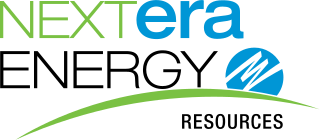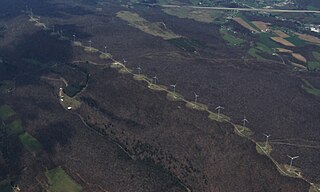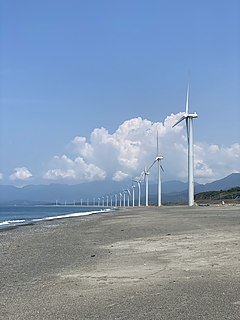Related Research Articles

Pumped-storage hydroelectricity (PSH), or pumped hydroelectric energy storage (PHES), is a type of hydroelectric energy storage used by electric power systems for load balancing. The method stores energy in the form of gravitational potential energy of water, pumped from a lower elevation reservoir to a higher elevation. Low-cost surplus off-peak electric power is typically used to run the pumps. During periods of high electrical demand, the stored water is released through turbines to produce electric power. Although the losses of the pumping process make the plant a net consumer of energy overall, the system increases revenue by selling more electricity during periods of peak demand, when electricity prices are highest. If the upper lake collects significant rainfall or is fed by a river then the plant may be a net energy producer in the manner of a traditional hydroelectric plant.

Wind power or wind energy is mostly the use of wind turbines to generate electricity. Wind power is a popular, sustainable, renewable energy source that has a much smaller impact on the environment than burning fossil fuels. Historically, wind power has been used in sails, windmills and windpumps but today it is mostly used to generate electricity. Wind farms consist of many individual wind turbines, which are connected to the electric power transmission network.

Grid energy storage is a collection of methods used for energy storage on a large scale within an electrical power grid. Electrical energy is stored during times when electricity is plentiful and inexpensive or when demand is low, and later returned to the grid when demand is high, and electricity prices tend to be higher.

The Moss Landing Power Plant is a natural gas powered electricity generation plant located in Moss Landing, California, United States, at the midpoint of Monterey Bay. Its large stacks are landmarks, visible throughout the Monterey Bay Area. The plant is owned and operated by Houston-based Dynegy and currently has a generation capacity of 1020 MW (net) from its two combined cycle generation units. It was once the largest power plant in the state of California, with a generation capacity of 2560 MW, before its two large supercritical steam units were retired in 2016.

Biglow Canyon Wind Farm is an electricity generating wind farm facility in Sherman County, Oregon, United States. It is owned by Portland, Oregon-based Portland General Electric and began operations in 2007. With the completion of phase 3 of the project it has a generating capacity of 450 megawatts. It is located roughly five miles (8 km) northeast of Wasco, Oregon, and about ten miles (16 km) southeast of Rufus, Oregon. Biglow Canyon Wind Farm covers 25,000 acres (10,000 ha) in the Columbia River Gorge.
The electricity sectors of the Republic of Ireland and Northern Ireland are integrated and supply 2.5 million customers from a combination of coal, peat, natural gas, wind and hydropower. In 2018 natural gas produced 51.8%, while wind turbines generated 28.1%, coal 7%, and peat 6.8% of Ireland's average electricity demand. In 2020 wind turbines generated 36.3% of Ireland's electrical demand, one of the highest wind power proportions in the world. While the United Kingdom was one of the first countries in the world to deploy commercial nuclear power plants, the island of Ireland has never had a nuclear power plant built on either side of the Irish border. Nuclear power in Ireland was discussed in the 1960s and 1970s but ultimately never phased in, with legislation now in place explicitly forbidding its introduction.

NextEra Energy Resources, LLC (NEER) is a wholesale electricity supplier based in Juno Beach, Florida. NEER is a subsidiary of NextEra Energy, a Fortune 200 company. Prior to 2009, NextEra Energy Resources was known as FPL Energy.
Narec, since 2014 known as the National Renewable Energy Centre, is a part of the Offshore Renewable Energy (ORE) Catapult, a British technology innovation and research centre for offshore wind power, wave energy, tidal energy and low carbon technologies. ORE Catapult's head office is in Glasgow, Scotland. The centre operates multi-purpose offshore renewable energy test and demonstration facilities. It is similar to other centres, such as NREL in the US and National Centre for Renewable Energies (CENER) in Spain. The National Renewable Energy Centre is based in Blyth, Northumberland.

Wind power in Illinois provided nearly 10% of the state's generated electrical power in 2020 powering 1,231,900 homes. At the end of 2020, Illinois had 6,300 megawatts (MW) of wind power installed, ranking fifth among states for installed wind turbine capacity. An additional 1,100 MW of wind power was under construction across the state at the end of 2020.
There is a large array of stakeholders that provide services through electricity generation, transmission, distribution and marketing for industrial, commercial, public and residential customers in the United States. It also includes many public institutions that regulate the sector. In 1996, there were 3,195 electric utilities in the United States, of which fewer than 1,000 were engaged in power generation. This leaves a large number of mostly smaller utilities engaged only in power distribution. There were also 65 power marketers. Of all utilities, 2,020 were publicly owned, 932 were rural electric cooperatives, and 243 were investor-owned utilities. The electricity transmission network is controlled by Independent System Operators or Regional Transmission Organizations, which are not-for-profit organizations that are obliged to provide indiscriminate access to various suppliers in order to promote competition.

The energy sector in Hawaii has rapidly adopted solar power due to the high costs of electricity, and good solar resources, and has one of the highest per capita rates of solar power in the United States. Hawaii's imported energy costs, mostly for imported petroleum and coal, are three to four times higher than the mainland, so Hawaii has motivation to become one of the highest users of solar energy. Hawaii was the first state in the United States to reach grid parity for photovoltaics. Its tropical location provides abundant ambient energy.

The Meyersdale Wind Farm is a wind farm located in Meyersdale, Somerset County, Pennsylvania with 20 NEG Micon/Vestas 1.5 MW wind turbines that began commercial operation in December 2003. The wind farm has a combined total nameplate capacity of 30 MW, enough to power about 10,000 homes. The project was constructed by NextEra Energy Resources, based in Florida.
In 2016, Arizona had 268 megawatts (MW) of wind powered electricity generating capacity, producing 0.5% of in-state generated electricity.
Modern United States wind energy policy coincided with the beginning of modern wind industry of the United States, which began in the early 1980s with the arrival of utility-scale wind turbines in California at the Altamont Pass wind farm. Since then, the industry has had to endure the financial uncertainties caused by a highly fluctuating tax incentive program. Because these early wind projects were fueled by investment tax credits based on installation rather than performance, they were plagued with issues of low productivity and equipment reliability. Those investment tax credits expired in 1986, which forced investors to focus on improving the reliability and efficiency of their turbines. The 1990s saw rise to a new type of tax credit, the production tax credit, which propelled technological improvements to the wind turbine even further by encouraging investors to focus on electricity output rather than installation.

Wind power in the Philippines accounts for a total of 443MW as of 2020 according to the Department of Energy, covering about 1.6% of the country's total installed capacity for both renewable and non-renewable energy sources. When it comes to existing renewable energy sources in the country, wind power has a total share of approximately 5.4%. Despite currently being a small contributor to the country's energy mix, wind power installations have increased from 33MW in 2012-2013 to 337MW in 2014, 427MW in 2015-2018, and 443MW in 2019-2021. Moreover, the Department of Energy's National Renewable Energy Plan (NREP) 2020-2040 aims to commission 2,345MW of total wind power capacity by 2030. There has been a setback, however, as the wind power industry was moderately affected by COVID, particularly in the import of wind turbines. Due to this, several projects such as the Aklan onshore wind project got delayed. To further drive the wind energy sector in the country, an increased demand for renewable energy, greater government commitments, and reduced wind power tariff are needed.

Wind power in Tennessee, which has significant potential in East Tennessee, is in the early stages of development. The state has not passed renewable portfolio standard legislation and there is just one utility-scale wind farm with 18 turbines. The Tennessee Valley Authority (TVA), based in Knoxville, imports wind-generated electricity into its service area which includes Tennessee. US Senator Lamar Alexander from Tennessee is an outspoken critic of wind power.
The Port Augusta Renewable Energy Park is a combined wind and solar farm under construction south of Port Augusta in South Australia, Australia. The solar farm is planned to be at the northern end of the site, west of the Augusta Highway and south of Sundrop Farms. The wind turbines will be on both sides of the Augusta Highway, extending south as far as the road to Horrocks Pass. Construction formally started in October 2020 and is estimated to take about 18 months to complete. The total site is about 5,400 hectares.
References
- ↑ Flaccus, Gillian (September 28, 2022). "Tiny Oregon town hosts 1st wind-solar-battery 'hybrid' plant". KATU. Associated Press. Retrieved September 29, 2022.
- ↑ "State of Oregon: Facilities - Boardman to Hemingway Transmission Line". oregon.gov. Retrieved June 14, 2021.
- ↑ "Wheatridge Wind seeks interconnect order for 500-MW project in Oregon | Transmission Intelligence Service". transmissionhub.com. January 9, 2017. Retrieved June 14, 2021.
- ↑ "State of Oregon: Facilities - Wheatridge Wind Energy Facility". oregon.gov. Retrieved June 14, 2021.
- ↑ "PGE's Wheatridge Renewable Energy Facility Begins Generating Power | North American Windpower". nawindpower.com. December 8, 2020. Retrieved June 14, 2021.
- ↑ "APPLICATION FOR ORDER DIRECTING GENERATOR INTERCONNECTION AND TRANSMISSION SERVICE" (PDF). transmissionhub.com. 2017. Retrieved June 14, 2021.
- ↑ Adair, Rick (April 3, 2020). "UEC Planning Line for Load Growth; Wheatridge Wind Evolves". NewsData, LLC. Retrieved June 14, 2021.
- 1 2 "Wheatridge Renewable Energy Facility info sheet" (PDF). assets.ctfassets.net. Retrieved June 14, 2021.
- ↑ JADE MCDOWELL (December 14, 2020). "First phase of Wheatridge Renewable Energy Facility now online". Hermiston Herald. Retrieved June 14, 2021.